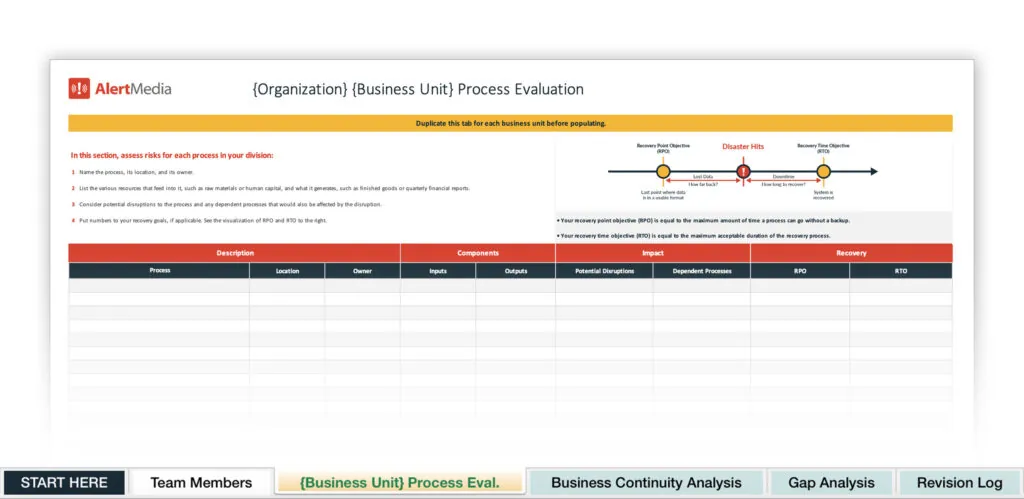
What Is a Business Impact Analysis (BIA)? How to Conduct Your Own in 5 Steps
Business resilience starts with an impact analysis. Learn how to identify critical operations, tackle risks, and build smart recovery plans to help you bounce back stronger.

When a hive-style cyberattack hit Memorial Health System, it brought operations to a standstill. Critical diagnostic machines, like MRIs, stopped working. On The Employee Safety Podcast, we spoke with Lori Price, the Emergency Management Coordinator at Memorial, about the event. Digital medical records became inaccessible, forcing teams to revert to outdated paper backups. On top of that, vendors refused to connect with contaminated servers, payroll stalled, and cafeteria cash registers lost internet access.
—Lori Price, Emergency Management Coordinator, Memorial Health System
Because they had prepared with a business impact analysis, Memorial adapted quickly and continued delivering lifesaving care. Without that preparation, the cascade of problems could have been far worse. While we can’t avert every crisis, a business impact analysis helps you plan for disruptions and reduce the fallout when problems happen.
In this post, we’ll guide you through key business impact analysis steps and explain how this assessment informs your disaster recovery, business continuity, and emergency response plans.
Business Impact Analysis Template
What Is a Business Impact Analysis (BIA)?
A business impact analysis or business impact assessment (BIA) is a structured process to help you understand and prepare for potential disruptions to your business operations. In simple terms, it’s a way to:
- Identify critical functions that are most important to keeping the company running
- Understand potential risks that could interrupt these critical functions and processes
- Estimate the financial and operational consequences of these disruptions
- Establish recovery time objectives, allocate resources, and prioritize recovery efforts
As a key piece of business continuity planning (BCP), the main goal of a BIA is to help businesses develop strategies to minimize damage and recover quickly if unexpected events occur. Disruptive events may include natural disasters, cyberattacks, equipment malfunctions, information security failures, or the loss of essential employees.
Possible (financial and non-financial) business impacts to consider may include:
- Lost or delayed revenue
- Increased expenses
- Regulatory fines and legal fees
- Contractual penalties
- Brand and reputational damage
- Customer churn or dissatisfaction
- Data loss
Keep in mind that the severity of a business impact often depends on the timing and duration of the disruption. A 30-second power outage is far less damaging than a 24-hour IT outage. Similarly, a fire in a remote warehouse causes less disruption than one in an active manufacturing facility. For retailers, an eCommerce outage during a major sale like Black Friday is far more critical than during a slower period.
A business impact analysis helps your organization prepare for all types of emergencies by analyzing potential disruptions and their effects on critical business processes.
Know How to Prioritize Recovery: Why You Need a BIA
Every business will face disturbances at some point, from severe weather and natural disasters to cyberattacks and workplace accidents. A business impact analysis (BIA) helps you prepare by minimizing the financial, operational, and reputational impacts of these challenges.
In a significant emergency, knowing where to start can be overwhelming. That’s why a BIA is essential for any emergency response strategy. It helps you:
- Understand how vital business processes are connected
- Define critical processes and operations that must recover quickly
- Identify the resources needed to keep the business running at minimal capacity
- Prioritize recovery efforts to reduce potential losses from major disruptions
- Assess how long your business can function without full capabilities
- Protect company assets and data
- Stay ahead of industry changes and gain a competitive edge
The faster you recover, the more you can save on costs, maintain customer trust, and keep employees productive. A BIA plan gives leaders confidence through awareness of recovery priorities and resource deployment to minimize downtime. With a solid plan, you won’t be scrambling when disaster strikes.
You can also use this free impact analysis template to simplify your BIA process.
Preview of AlertMedia’s Business Impact Analysis Template spreadsheet
How Business Impact Assessments Fit Into Business Continuity Planning
A BIA lays the foundation for an effective business continuity strategy. It identifies how disruptions impact critical business functions, ensuring your organization has a clear recovery plan and the resources needed to respond efficiently and with minimal disruption.
The insights from a BIA work in tandem with related planning efforts:
BIA vs. risk assessment
While a BIA focuses on the potential results of disruptions—prioritizing recovery goals and identifying critical functions—a risk assessment (or business threat assessment) identifies potential threats and evaluates their likelihood. Both processes complement each other to strengthen your overall resilience strategy.
BIA vs. disaster recovery planning
A BIA informs disaster recovery planning (DRP) by defining the critical functions that require immediate recovery. DRP builds on this foundation to outline the specific procedures and tools needed to restore operations.
BIA vs. business continuity planning
Business continuity planning (BCP) builds on the priorities and insights from a BIA to ensure the organization can continue operating during and after disruptions. While a BIA defines the “what” and “why,” a BCP focuses on the “how.”
Together, these provide a comprehensive approach to managing risks and ensuring business continuity.
How to Conduct a BIA in 5 Steps With a Business Impact Analysis Template
There’s no one-size-fits-all rulebook for conducting a business impact analysis; every company has unique methods and organizational needs. However, some common elements should go into every BIA process, and a great way to start is with a free BIA template like this one. It guides you through identifying critical processes and resources, assessing the severity of impacts, prioritizing recovery efforts, and tracking revisions.
Follow these business impact analysis steps to prioritize recovery, minimize losses, and prepare your organization for any crisis:

Step #1: Plan your approach
Before starting your analysis, take time to plan your approach. Set the scope, choose a methodology, and build a business impact analysis team to carry out the project.
Regarding the how, options include using a third-party consulting firm, reporting software with real-time analytics, or a BIA template to guide the process.
A BIA will often cover five main areas:
- Financial impact
- Reputational impact
- Regulatory impact
- Production impact
- Environmental impact
Depending on your organization, you might focus on different or additional impact areas, such as customer impact, operational impact, worker impact, or governance impact.
A BIA team should include the following leading roles:
- Project leader: Primary contact responsible for conducting a successful business impact analysis.
- Executive sponsor: Executive champion responsible for providing strategic input and guidance.
- Business process owners: Representatives from different business units, such as IT and Finance, who will provide insights into relevant business processes, aid decision-making, and help implement BIA recommendations.
Business process owners are key to a BIA team because they understand how disruptions will impact their specific areas and can predict cascading effects. For example, a supply chain owner can quickly identify how a delay in delivery will affect production, inventory, and customer service, helping the team prioritize recovery actions.
—Erica Reed, Business Resilience Analyst, Macy’s
Here’s a more comprehensive look at which business process owners you may include on your business impact analysis project team, along with each team member’s responsibilities:
- IT leader: Review IT applications and software systems to confirm if current disaster recovery (DR) plans meet the required recovery time objectives (RTOs).
- Legal: Consider regulatory requirements, contractual obligations, fines, and legal liabilities that may come up during business disruptions.
- Risk management leader: Determine the key business risks, define the risk threshold, and help develop the impact parameters.
- Finance: Supply financial data and advice on direct and indirect financial impacts.
- Operations leader: Provide information on critical supply chain dependencies, production-related activities, and operational impacts.
- Human resources leader: Consider duty of care obligations, compliance, and employee health and safety.
- Facilities leader: Supply information on facilities, utilities, alternative recovery work locations, etc.
Use the BIA template to easily keep track of team members, including their roles, responsibilities, contact information, and normal work location, so you know how to find them if questions arise.
Step #2: Gather business process information
With your all-star team assembled, it’s time to roll up your sleeves and gather information. At this stage, you’ll want to use various techniques to collect valuable insights from business process owners and key stakeholders. You’ll distribute BIA questionnaires, conduct interviews, and review relevant documents. Each method captures different perspectives and data types essential for understanding business activities, potential disruptions, and their consequences.
In your BIA interviews and surveys, make sure to capture key information about the business processes you’re analyzing, including:
- Name of the process
- Where it’s performed
- Inputs and outputs
- Resources and tools used
- Any process interdependencies
- Types of impact (financial, operational, regulatory, etc.)
- Impact of changes/disruptions
- How the timing and duration of a given disruption affect its impact
Use the Business Unit (Process Evaluation) section of our business impact analysis template to keep track of this information.
Interviews
Interviews are key to gathering in-depth insights. When doing interviews, focus on individuals who comprehensively understand specific business functions—such as department heads, process owners, and front-line employees.
These conversations can uncover nuances about interdependencies, workflows, and processes that a questionnaire alone might miss. Prepare open-ended questions to encourage discussion and extract detailed answers, like:
- “What would happen if this process were delayed or interrupted?”
- “Which resources are critical for the process to function properly?”
- “What’s the worst-case scenario if you lost access to this tool or system?”
Document responses thoroughly, and consider recording interviews (with permission) using tools like Zoom, Microsoft Teams, or Google Meet for remote interviews. AI platforms like Otter or Fathom can also help with note-taking and transcribing.
Surveys
Surveys or questionnaires are effective for reaching a broad audience quickly. Customize your BIA survey to collect quantitative and qualitative data, which will help you identify trends and outliers. Use multiple-choice or rating scale questions to quantify the importance of various processes and open-ended questions to gather more qualitative feedback. An example of a survey question might be:
- “How critical is this business process to overall operations on a scale of 1 to 5?”
- “How would a disruption to this process impact revenue, customer service, or compliance?”
Survey tools like SurveyMonkey, Google Forms, or Typeform are perfect for this step, allowing easy distribution and data analysis.
Document reviews
In addition to interviews and surveys, review relevant documents such as standard operating procedures (SOPs), flowcharts, financial reports, and previous BIA or risk assessment reports. These documents offer hard data on existing workflows, resource allocation, and historical disruptions. By cross-referencing document information with interview and survey data, you’ll gain a fuller picture of how each process functions and how disruptions could impact the organization.
Example of data collection in action
Imagine you’re conducting a BIA for a manufacturing company. You survey department heads about their processes, asking them to rate the criticality of their operations. You then interview a production manager who provides detailed insights into how delays in raw material shipments affect the entire production line.
The survey reveals that the production line is highly critical. Meanwhile, the interview shows that the lack of raw materials delays multiple downstream processes, from assembly to shipping. You also review SOPs to understand resource allocation and identify the most essential materials. Together, these methods paint a comprehensive picture of the business’s vulnerabilities.
Step #3: Evaluate your information to determine key data points
With your data in hand, the next step is to thoroughly assess the information to determine which processes are most critical to your organization’s survival during a disruption. This step involves identifying priorities and pulling actionable insights into your recovery plan.
Start by evaluating the severity of potential disruptions and the resources each process requires. Use clear metrics to assess criticality and potential impact across several dimensions, including financial, operational, and regulatory factors.
Key questions to answer in this stage:
- Which business functions are most important to business continuity?
- What will the cascading effects be if these functions are disrupted?
- What resources (people, technology, and systems) are necessary for the seamless continuation of each process?
- What is the recovery timeframe for each critical process? Consider using time-based indicators to benchmark recovery efforts:
- Recovery Time Objectives (RTOs): The maximum time of a process interruption before significant harm occurs
- Recovery Point Objectives (RPOs): The maximum acceptable amount of data loss in the event of a disruption
- Maximum Allowable Outages (MAOs): The longest duration of a process disruption before it impacts business operations
- Maximum Tolerable Period of Disruption (MTPD): The amount of time your business can operate without a specific function before it jeopardizes business viability
Use the Business Continuity Analysis section of the template to rank processes (using a score of 1–5) based on their criticality and the potential severity of disruption. Visualize interdependencies between different business units to understand disruptions’ cascading effects on operational and financial levels.
Once you establish these elements, align your findings with clear, actionable objectives. Identify owners for each process, define accountability structures, and determine specific timelines for recovery activities. This way, your BIA report isn’t just a set of observations—it drives measurable action and continuous improvement.
Step #4: Create your BIA report to aid business continuity and disaster recovery
After completing the data gathering and analysis phases, it’s time to compile the findings into a clear, actionable business impact analysis report. This report is not just a summary of the data—it’s a roadmap for business continuity and disaster recovery.
Key elements to include in your BIA report:
- Executive summary: Provide a concise overview of the most critical findings, focusing on the business processes that could most impact operations.
- Prioritization of business functions: List business processes in order of importance, focusing on those with the most significant financial, operational, and reputational risks.
- Impact analysis: Document potential disruptions for each critical business function, including the severity of impact across financial, regulatory, operational, and environmental areas.
- Recovery timelines: Clearly outline each process’s defined recovery time objectives (RTOs), recovery point objectives (RPOs), and any other key performance indicators like MAOs or MTPD.
- Risk mitigation strategies: Outline the steps to address vulnerabilities and ensure recovery times. For example, if current disaster recovery strategies have gaps, such as failure to meet recovery time objectives, recommend additional resources or alternative strategies.
- Actionable recommendations: Provide clear next steps for improving business resilience, including resource allocation, necessary training, and additional risk management actions.
This report is a tool for communicating with senior management and serves as a foundational document for guiding the development of the company’s continuity plan.
For example, the BIA identifies that the company’s emergency communication system is critical for informing employees during a crisis. The report would recommend prioritizing the restoration of this system first, meaning that steps should be taken immediately to repair, reboot, or activate the system in case of a disruption.
These actions ensure that employees can be quickly informed and coordinated during a crisis. If the communication system fails to meet recovery time objectives (RTO), the report will highlight the risks of delays, such as confusion or inefficiencies in managing the crisis.
Step #5: Implement recommendations and monitor progress
The final step is about turning your business impact analysis report into action. The best business continuity and disaster recovery plans are only effective when you actively implement (and regularly update) recommendations and protocols.
Here’s how to make it happen:
- Secure buy-in from stakeholders: Get executive support and alignment with the recommendations. The executive sponsor, business owners, and department leads must champion the implementation of the BIA’s recommendations. This support will ensure that necessary resources and changes are allocated.
- Assign ownership: Designate who is responsible for each recovery task. Each critical process should have an owner to track its recovery progress, ensuring accountability and execution.
- Execution: Begin implementing the prioritized recommendations to mitigate risks that could lead to extended downtime or loss. This may involve upgrading information systems, improving third-party service level agreements (SLAs), or refining communication protocols.
- Monitor and revisit: Business impact analysis is not a one-time exercise. Your BIA should evolve as the organization grows, changes, or faces new challenges. Regularly review and adjust the BIA report, ensuring it stays current with new business processes, structural shifts, and available resources. Use the revision log in our free BIA template to keep track of changes to your business impact analysis.
One practical action might involve conducting regular tabletop exercises to test the effectiveness of the emergency communication system. The BIA report could recommend holding quarterly exercises, where employees simulate crisis scenarios and practice using the system to communicate urgent information. Exercises like this help identify gaps in the plan, ensuring that the system works as intended when real disruptions occur.
Or, as another example, let’s say the BIA identifies that a critical supply chain process relies heavily on a third-party vendor, and any disruption to their services could lead to significant financial losses. In this case, you might recommend establishing a backup supplier network or creating a buffer stock of essential materials.
This action step ensures that your business can continue operations even if the primary supplier fails to meet recovery objectives. Revisit this recommendation regularly to keep your continuity plans aligned with evolving supply chain dynamics and minimize future risks.
A BIA Is Your Strategic Path to Resilience
A comprehensive business impact analysis is more than just an exercise—it’s vital to your disaster recovery, business continuity, and emergency response planning. Like Memorial Health System’s swift response to a cyberattack, identifying critical systems and key vulnerabilities can dramatically reduce downtime and chaos.
Integrating BIA into your continuity planning strengthens your recovery process and aligns with best practices such as those outlined in ISO 22301, a global standard for business continuity management. Ultimately, understanding your critical operations today makes your recovery stronger tomorrow.





![Disaster and Emergency Communication Plan—5 Steps [+Template]](https://www.alertmedia.com/wp-content/uploads/2022/03/BLOG-Emergency-Communications-Plan-V1.jpg)
